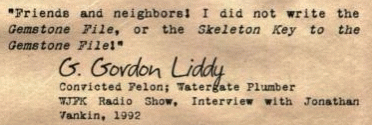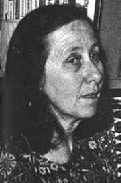[Previously published in the Sleuth Journal]
In 1975 an extraordinary document surfaced called "A Skeleton Key to the Gemstone File." Distributed hand-to-hand long before the advent of computer-based social media, the 22-page typed copy I received in 1976 had been reproduced so many times that several words and letters were unclear or missing. Evidently a fervent underground effort had been underway to get this information out. So I've kept a copy of the Skeleton Key around for the last four decades taking notes on developments, and recent history, so far, has increased my confidence in the document's veracity.
The Skeleton Key's genesis involves a conspiracy-themed radio talk show host named Mae Brussell ne'e Magnin, who lived in Carmel Valley, California in the early 1970s and was related to the founder of San Francisco's fashionable and prosperous I. Magnin department store chain. A local news director had introduced Brussell to Stephanie Caruana, then a contributing editor at Playgirl magazine. Although some question the Key's authorship, it is generally attributed to Caruana who told me she wrote it. She said it was the Patty Hearst kidnapping that resulted in her meeting Brussell.
"I was just ranting with curiosity about Patty Hearst because she was living around a mile from me in Berkeley when the kidnap happened, and this whole massive publicity campaign got underway. I was saying, 'What is going on here? This doesn't seem like a normal case.' It was so overblown,'" Caruana said. "The mass media get on a story and everybody covers the same story day after day, but if you really know what's going on, you may suspect that there is something else going on underneath, something they're not paying any attention to."
On February 4, 1974, a group of "revolutionaries" using the contrived appellation, "Symbionese Liberation Army" (SLA), abducted Patty Hearst-- the 19-year-old granddaughter of newspaper magnate William Randolph Hearst--who was attending the public university in Berkeley, California. The Skeleton Key refers to the SLA episode this way: "February 1974: Mafia Hearst's daughter, Patty, "kidnapped" by Lipset's SLA in a fake terrorist action." Hal Lipset was a San Francisco private investigator whose name also appears in the Skeleton Key connected to the Watergate debacle.
The SLA began in 1971 as a loose-knit group of mostly middle and upper-class white radicals who embraced a melange of philosophies endorsing selective violence and crime to initiate social change. While a few members were in prison, they met Donald "Cinque" DeFreeze during meetings of the "Black Cultural Association." After DeFreeze conveniently escaped from prison in 1972, he contacted SLA members in Oakland and eventually assumed leadership of the group, which engaged in kidnappings, bank robberies, assassinations--and feeding the poor, all in an apparent effort to foment revolution.
After abducting Patty Hearst, the SLA demanded that large amounts of food be donated to poor people in exchange for the heiress's release. Patty's father, Randolph Hearst, president of the San Francisco Examiner, agreed to pay an initial $2 million in ransom, and food was distributed at several sites. According to The Realist publisher Paul Krassner, when the governor, Ronald Reagan, saw one of the long lines of people waiting for food, he groused, "I hope they get botulism." Due to lack of adequate organization the food giveaway was a disaster, so the SLA refused to release Hearst.
Caruana had given Krassner a copy of the Skeleton Key in 1975, the same year he began reporting on the upcoming Hearst trial for the Berkeley Barb. In his 2014 book, Patty Hearst and the Twinkie Murders: A Tale of Two Trials, Krassner outlines a case to support a bold claim. "Donald "Cinque" DeFreeze," he says, "was a double agent."

Patty Hearst robs Hibernia Bank, 1974
(Image by (From Wikimedia) Closed circuit security camera, Author: Closed circuit security camera) Details Source DMCA
Brussell too believed that a clandestine arm of the US government either created or manipulated the SLA as a tool of espionage designed to distort the message of idealism. The root of the neologism "Symbionese," the Greek "symbiosis," means "a living together" as in peace, harmony, and balance--among the subversive ideas and ideals that the operation apparently tried to undermine. Krassner, once a member of Ken Kesey's Merry Pranksters and the first living inductee of the Counterculture Hall of Fame, had published Brussell's early articles on the Watergate antagonists. "She really did scoop everybody," Caruana said. "I believe she got that information from Roberts' Gemstone papers because he certainly had the goods on those people. He knew all about them."
The public generally assumed Hearst was being held against her will, so it was especially dramatic when on April 3, 1974, she announced that she had joined the SLA to fight for the oppressed and had adopted the "revolutionary" name, Tania." After a security camera filmed her helping the SLA rob a San Francisco bank on April 15, the public assumed she was being coerced or brainwashed. Subsequently, the group fled south to Los Angeles where members sequestered themselves in a south-central community until a suspicious neighbor tipped off the Los Angeles Police Department (LAPD).
Militarization of the police was relatively new then, and I recall seeing on television the impressive public demonstration by the LAPD's Special Weapons and Tactics (SWAT) unit of its new and very expensive military-grade equipment. So, not unexpectedly, on May 17, 1974, live cameras allowed the country to watch the house burn down with SLA members inside--presaging later events such as the destruction of the MOVE complex in Philadelphia and the "Branch Davidian" compound in Waco, Texas. When officials began investigating, everyone wondered if Patty Hearst was inside. She wasn't. Six had perished, but the rest had escaped. Patty Hearst was caught on September 18, 1975 and went to trial in January of 1976. She served two years for "bank robbery" and "use of a dangerous weapon" before President Jimmy Carter commuted her sentence and President Bill Clinton later pardoned her.
In December of 1974 Playgirl magazine ran an article that Caruana and Brussell had co-authored called, "Is Howard Hughes Dead and Buried Off An Island In Greece ?" It involved the disappearance of Texas multi-millionaire Howard Hughes and Greek billionaire Aristotle Onassis, but after examining the file folder of notes Brussell had provided, Caruana told her she had found little evidence to justify an article accusing either man of misdeeds. At that point, Caruana said, Brussell reluctantly produced a file containing several hundred handwritten notes, letters, articles and news clippings of a man named Bruce Porter Roberts along with specific instructions on when and how to read them. Brussell stressed that it was easy to get "lost" in the material and imposed specific conditions on its reading. Caruana, cloistered in a bedroom at Brussell's house, read into the early morning, increasingly absorbed in a sordid tale of political intrigue, thievery, and murder. Caruana wrote the Playgirl article based on the revelations contained in those pages.

Playgirl issue that ran the article by Brussel and Caruana
(Image by Shawn Hamilton (scan)) Details DMCA
(Note: You can view every article as one long page if you sign up as an Advocate Member, or higher).






